Professional Development Report: Skills Assessment and Strategies
VerifiedAdded on 2022/09/15
|13
|3131
|17
Report
AI Summary
This report analyzes methods and techniques for professional development, focusing on the career goal of becoming a Chief Executive Officer (CEO) at the Land Transport Directorate within Transport Malta. The author, a Director at the organization, explores various methods to evaluate both personal and professional skills. The report discusses the Big Five personality test and self-assessment techniques to evaluate personal skills, highlighting their advantages and disadvantages. It further examines 360-degree feedback and competency self-assessment surveys as tools for assessing professional skills, also detailing their pros and cons. The report emphasizes the importance of self-awareness, identifying strengths and weaknesses, and using these insights to guide professional development. The conclusion stresses the dynamic and complex nature of professional development and the need for continuous improvement to achieve career aspirations.
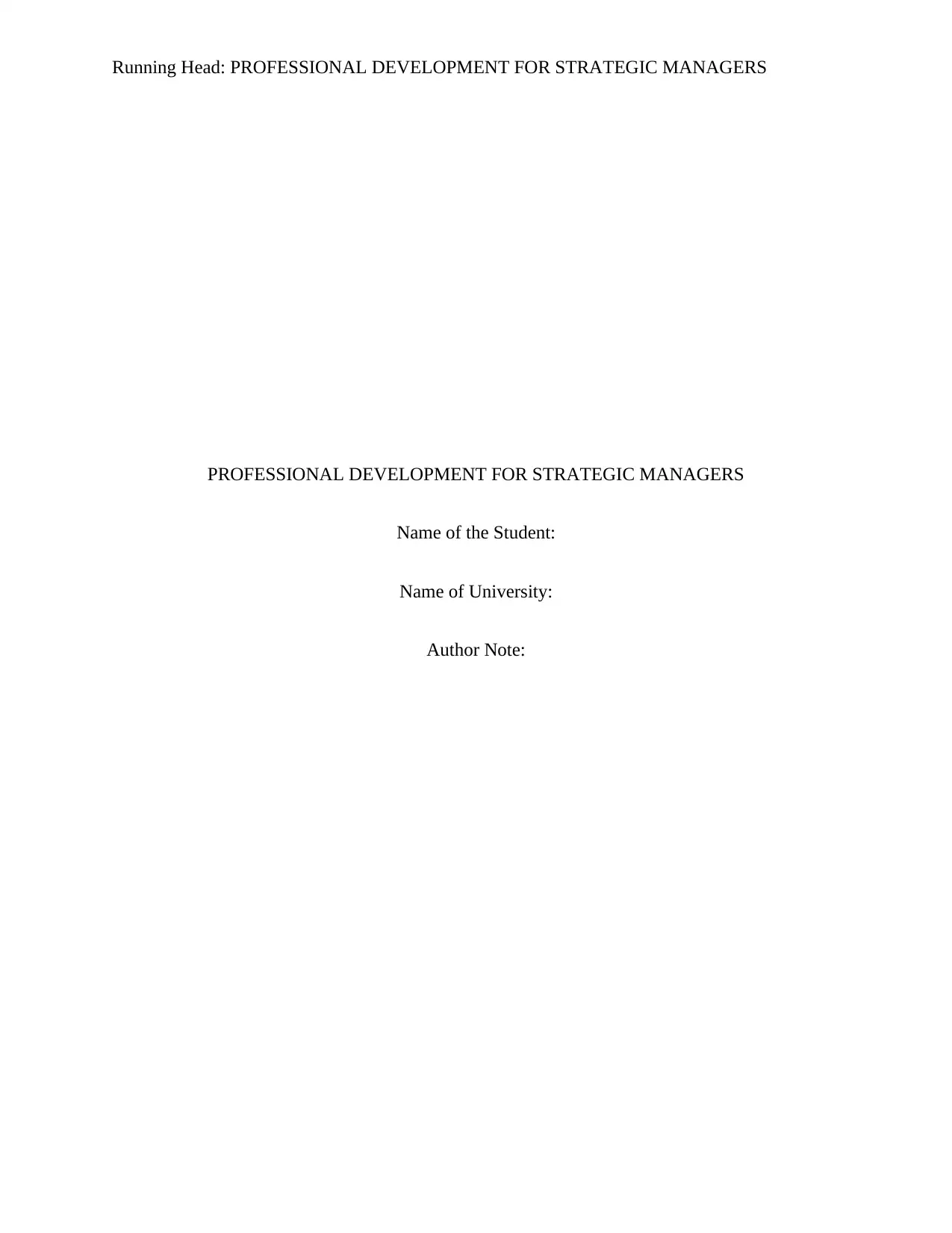
Running Head: PROFESSIONAL DEVELOPMENT FOR STRATEGIC MANAGERS
PROFESSIONAL DEVELOPMENT FOR STRATEGIC MANAGERS
Name of the Student:
Name of University:
Author Note:
PROFESSIONAL DEVELOPMENT FOR STRATEGIC MANAGERS
Name of the Student:
Name of University:
Author Note:
Paraphrase This Document
Need a fresh take? Get an instant paraphrase of this document with our AI Paraphraser
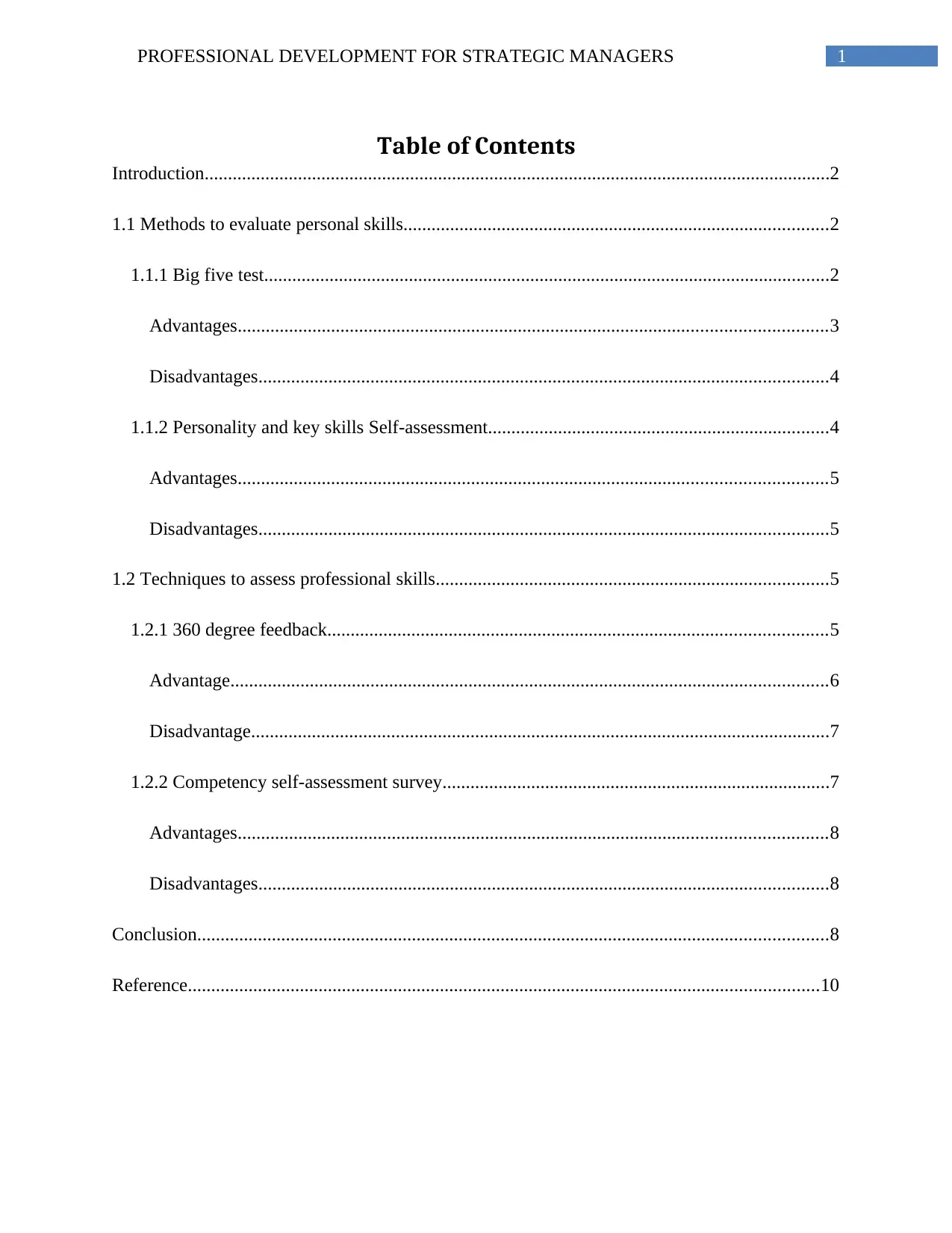
1PROFESSIONAL DEVELOPMENT FOR STRATEGIC MANAGERS
Table of Contents
Introduction......................................................................................................................................2
1.1 Methods to evaluate personal skills...........................................................................................2
1.1.1 Big five test.........................................................................................................................2
Advantages..............................................................................................................................3
Disadvantages..........................................................................................................................4
1.1.2 Personality and key skills Self-assessment.........................................................................4
Advantages..............................................................................................................................5
Disadvantages..........................................................................................................................5
1.2 Techniques to assess professional skills....................................................................................5
1.2.1 360 degree feedback...........................................................................................................5
Advantage................................................................................................................................6
Disadvantage............................................................................................................................7
1.2.2 Competency self-assessment survey...................................................................................7
Advantages..............................................................................................................................8
Disadvantages..........................................................................................................................8
Conclusion.......................................................................................................................................8
Reference.......................................................................................................................................10
Table of Contents
Introduction......................................................................................................................................2
1.1 Methods to evaluate personal skills...........................................................................................2
1.1.1 Big five test.........................................................................................................................2
Advantages..............................................................................................................................3
Disadvantages..........................................................................................................................4
1.1.2 Personality and key skills Self-assessment.........................................................................4
Advantages..............................................................................................................................5
Disadvantages..........................................................................................................................5
1.2 Techniques to assess professional skills....................................................................................5
1.2.1 360 degree feedback...........................................................................................................5
Advantage................................................................................................................................6
Disadvantage............................................................................................................................7
1.2.2 Competency self-assessment survey...................................................................................7
Advantages..............................................................................................................................8
Disadvantages..........................................................................................................................8
Conclusion.......................................................................................................................................8
Reference.......................................................................................................................................10
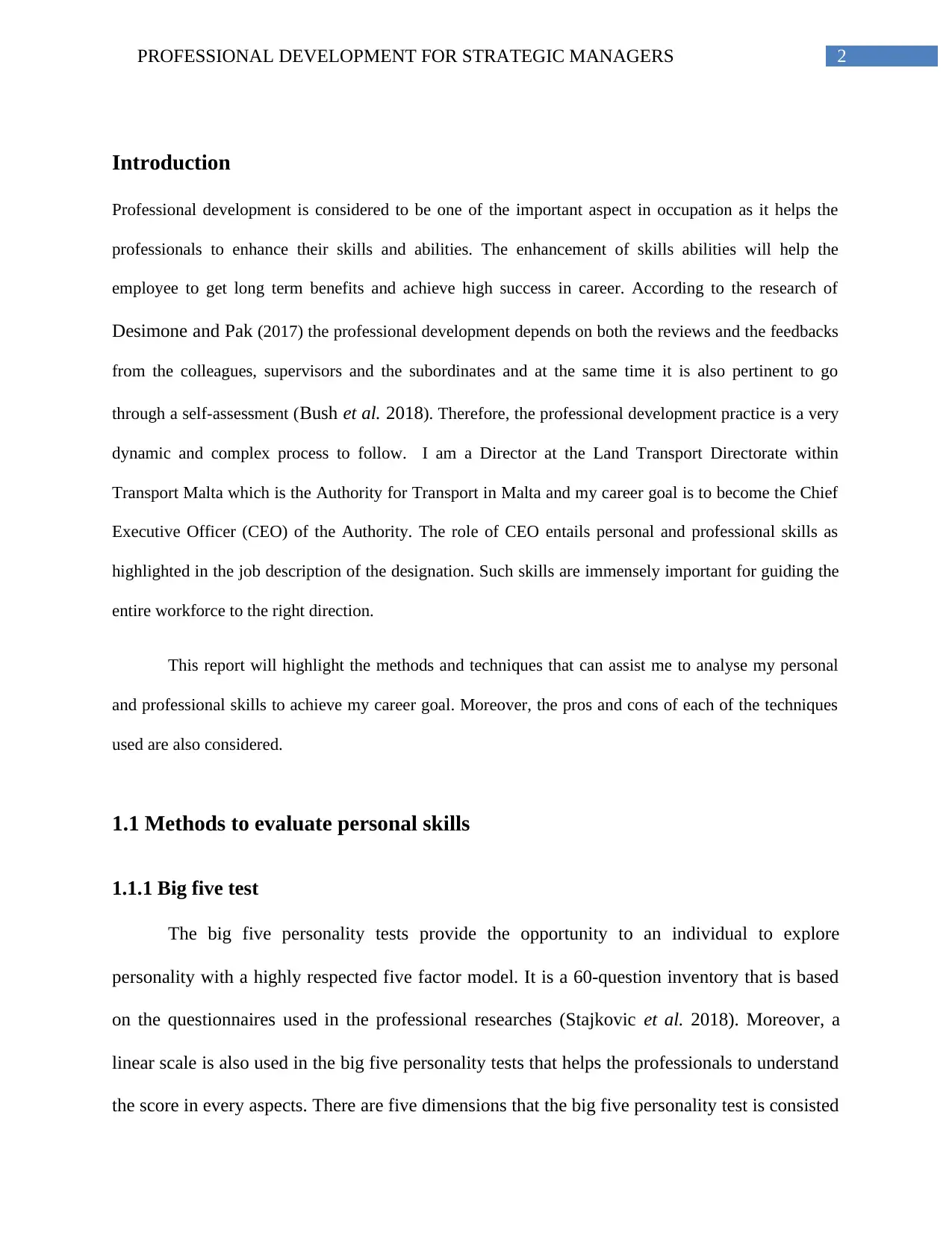
2PROFESSIONAL DEVELOPMENT FOR STRATEGIC MANAGERS
Introduction
Professional development is considered to be one of the important aspect in occupation as it helps the
professionals to enhance their skills and abilities. The enhancement of skills abilities will help the
employee to get long term benefits and achieve high success in career. According to the research of
Desimone and Pak (2017) the professional development depends on both the reviews and the feedbacks
from the colleagues, supervisors and the subordinates and at the same time it is also pertinent to go
through a self-assessment (Bush et al. 2018). Therefore, the professional development practice is a very
dynamic and complex process to follow. I am a Director at the Land Transport Directorate within
Transport Malta which is the Authority for Transport in Malta and my career goal is to become the Chief
Executive Officer (CEO) of the Authority. The role of CEO entails personal and professional skills as
highlighted in the job description of the designation. Such skills are immensely important for guiding the
entire workforce to the right direction.
This report will highlight the methods and techniques that can assist me to analyse my personal
and professional skills to achieve my career goal. Moreover, the pros and cons of each of the techniques
used are also considered.
1.1 Methods to evaluate personal skills
1.1.1 Big five test
The big five personality tests provide the opportunity to an individual to explore
personality with a highly respected five factor model. It is a 60-question inventory that is based
on the questionnaires used in the professional researches (Stajkovic et al. 2018). Moreover, a
linear scale is also used in the big five personality tests that helps the professionals to understand
the score in every aspects. There are five dimensions that the big five personality test is consisted
Introduction
Professional development is considered to be one of the important aspect in occupation as it helps the
professionals to enhance their skills and abilities. The enhancement of skills abilities will help the
employee to get long term benefits and achieve high success in career. According to the research of
Desimone and Pak (2017) the professional development depends on both the reviews and the feedbacks
from the colleagues, supervisors and the subordinates and at the same time it is also pertinent to go
through a self-assessment (Bush et al. 2018). Therefore, the professional development practice is a very
dynamic and complex process to follow. I am a Director at the Land Transport Directorate within
Transport Malta which is the Authority for Transport in Malta and my career goal is to become the Chief
Executive Officer (CEO) of the Authority. The role of CEO entails personal and professional skills as
highlighted in the job description of the designation. Such skills are immensely important for guiding the
entire workforce to the right direction.
This report will highlight the methods and techniques that can assist me to analyse my personal
and professional skills to achieve my career goal. Moreover, the pros and cons of each of the techniques
used are also considered.
1.1 Methods to evaluate personal skills
1.1.1 Big five test
The big five personality tests provide the opportunity to an individual to explore
personality with a highly respected five factor model. It is a 60-question inventory that is based
on the questionnaires used in the professional researches (Stajkovic et al. 2018). Moreover, a
linear scale is also used in the big five personality tests that helps the professionals to understand
the score in every aspects. There are five dimensions that the big five personality test is consisted
⊘ This is a preview!⊘
Do you want full access?
Subscribe today to unlock all pages.

Trusted by 1+ million students worldwide
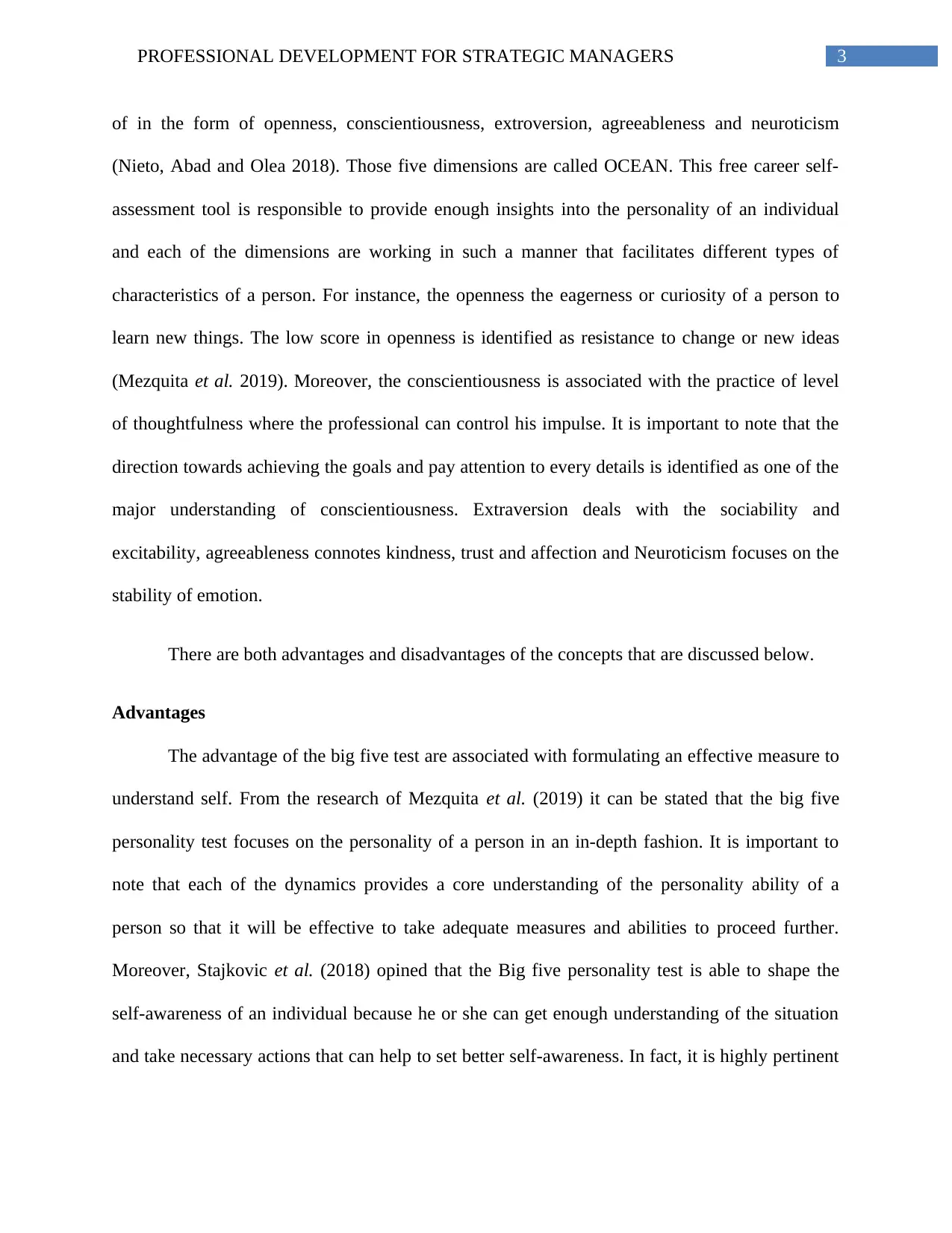
3PROFESSIONAL DEVELOPMENT FOR STRATEGIC MANAGERS
of in the form of openness, conscientiousness, extroversion, agreeableness and neuroticism
(Nieto, Abad and Olea 2018). Those five dimensions are called OCEAN. This free career self-
assessment tool is responsible to provide enough insights into the personality of an individual
and each of the dimensions are working in such a manner that facilitates different types of
characteristics of a person. For instance, the openness the eagerness or curiosity of a person to
learn new things. The low score in openness is identified as resistance to change or new ideas
(Mezquita et al. 2019). Moreover, the conscientiousness is associated with the practice of level
of thoughtfulness where the professional can control his impulse. It is important to note that the
direction towards achieving the goals and pay attention to every details is identified as one of the
major understanding of conscientiousness. Extraversion deals with the sociability and
excitability, agreeableness connotes kindness, trust and affection and Neuroticism focuses on the
stability of emotion.
There are both advantages and disadvantages of the concepts that are discussed below.
Advantages
The advantage of the big five test are associated with formulating an effective measure to
understand self. From the research of Mezquita et al. (2019) it can be stated that the big five
personality test focuses on the personality of a person in an in-depth fashion. It is important to
note that each of the dynamics provides a core understanding of the personality ability of a
person so that it will be effective to take adequate measures and abilities to proceed further.
Moreover, Stajkovic et al. (2018) opined that the Big five personality test is able to shape the
self-awareness of an individual because he or she can get enough understanding of the situation
and take necessary actions that can help to set better self-awareness. In fact, it is highly pertinent
of in the form of openness, conscientiousness, extroversion, agreeableness and neuroticism
(Nieto, Abad and Olea 2018). Those five dimensions are called OCEAN. This free career self-
assessment tool is responsible to provide enough insights into the personality of an individual
and each of the dimensions are working in such a manner that facilitates different types of
characteristics of a person. For instance, the openness the eagerness or curiosity of a person to
learn new things. The low score in openness is identified as resistance to change or new ideas
(Mezquita et al. 2019). Moreover, the conscientiousness is associated with the practice of level
of thoughtfulness where the professional can control his impulse. It is important to note that the
direction towards achieving the goals and pay attention to every details is identified as one of the
major understanding of conscientiousness. Extraversion deals with the sociability and
excitability, agreeableness connotes kindness, trust and affection and Neuroticism focuses on the
stability of emotion.
There are both advantages and disadvantages of the concepts that are discussed below.
Advantages
The advantage of the big five test are associated with formulating an effective measure to
understand self. From the research of Mezquita et al. (2019) it can be stated that the big five
personality test focuses on the personality of a person in an in-depth fashion. It is important to
note that each of the dynamics provides a core understanding of the personality ability of a
person so that it will be effective to take adequate measures and abilities to proceed further.
Moreover, Stajkovic et al. (2018) opined that the Big five personality test is able to shape the
self-awareness of an individual because he or she can get enough understanding of the situation
and take necessary actions that can help to set better self-awareness. In fact, it is highly pertinent
Paraphrase This Document
Need a fresh take? Get an instant paraphrase of this document with our AI Paraphraser
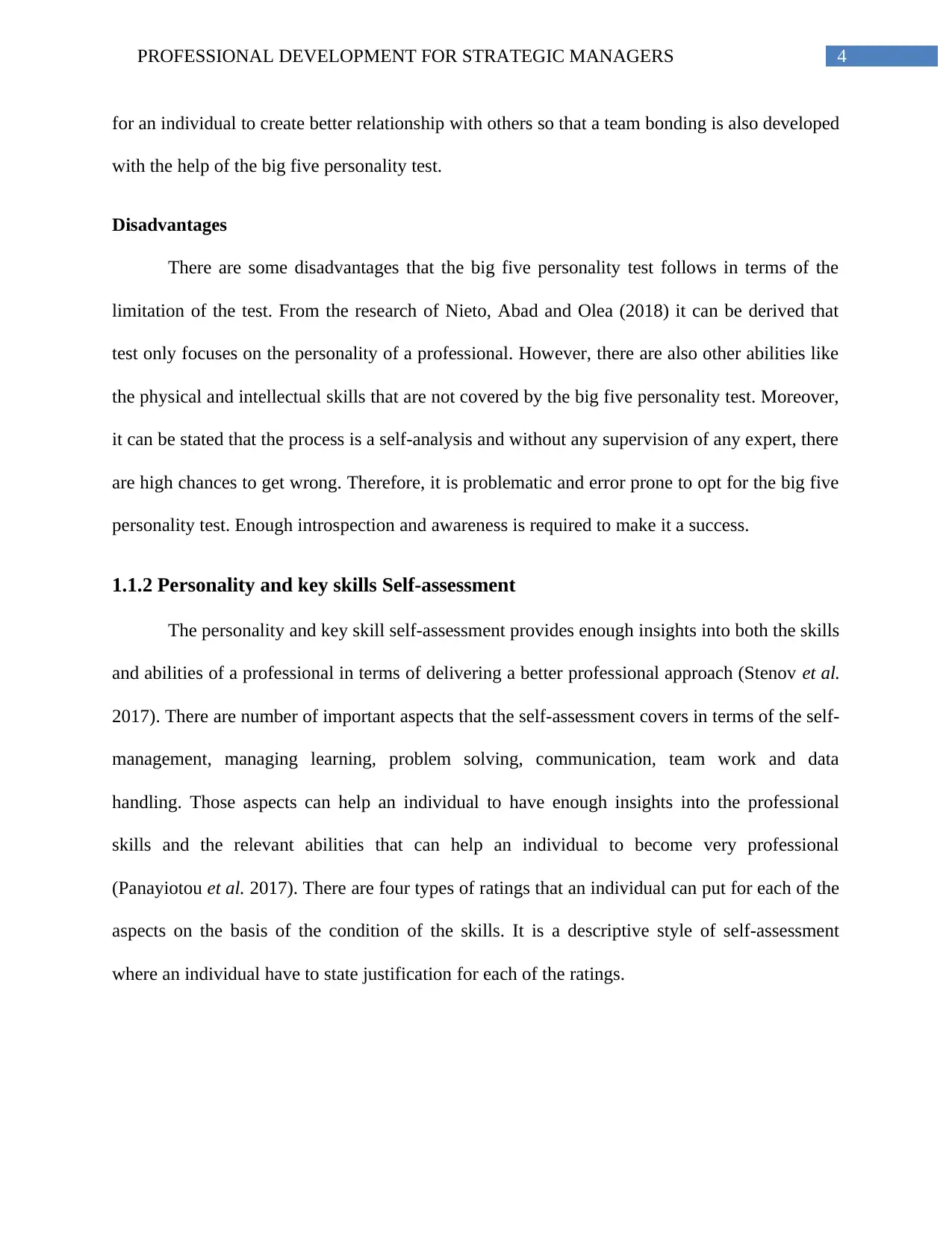
4PROFESSIONAL DEVELOPMENT FOR STRATEGIC MANAGERS
for an individual to create better relationship with others so that a team bonding is also developed
with the help of the big five personality test.
Disadvantages
There are some disadvantages that the big five personality test follows in terms of the
limitation of the test. From the research of Nieto, Abad and Olea (2018) it can be derived that
test only focuses on the personality of a professional. However, there are also other abilities like
the physical and intellectual skills that are not covered by the big five personality test. Moreover,
it can be stated that the process is a self-analysis and without any supervision of any expert, there
are high chances to get wrong. Therefore, it is problematic and error prone to opt for the big five
personality test. Enough introspection and awareness is required to make it a success.
1.1.2 Personality and key skills Self-assessment
The personality and key skill self-assessment provides enough insights into both the skills
and abilities of a professional in terms of delivering a better professional approach (Stenov et al.
2017). There are number of important aspects that the self-assessment covers in terms of the self-
management, managing learning, problem solving, communication, team work and data
handling. Those aspects can help an individual to have enough insights into the professional
skills and the relevant abilities that can help an individual to become very professional
(Panayiotou et al. 2017). There are four types of ratings that an individual can put for each of the
aspects on the basis of the condition of the skills. It is a descriptive style of self-assessment
where an individual have to state justification for each of the ratings.
for an individual to create better relationship with others so that a team bonding is also developed
with the help of the big five personality test.
Disadvantages
There are some disadvantages that the big five personality test follows in terms of the
limitation of the test. From the research of Nieto, Abad and Olea (2018) it can be derived that
test only focuses on the personality of a professional. However, there are also other abilities like
the physical and intellectual skills that are not covered by the big five personality test. Moreover,
it can be stated that the process is a self-analysis and without any supervision of any expert, there
are high chances to get wrong. Therefore, it is problematic and error prone to opt for the big five
personality test. Enough introspection and awareness is required to make it a success.
1.1.2 Personality and key skills Self-assessment
The personality and key skill self-assessment provides enough insights into both the skills
and abilities of a professional in terms of delivering a better professional approach (Stenov et al.
2017). There are number of important aspects that the self-assessment covers in terms of the self-
management, managing learning, problem solving, communication, team work and data
handling. Those aspects can help an individual to have enough insights into the professional
skills and the relevant abilities that can help an individual to become very professional
(Panayiotou et al. 2017). There are four types of ratings that an individual can put for each of the
aspects on the basis of the condition of the skills. It is a descriptive style of self-assessment
where an individual have to state justification for each of the ratings.
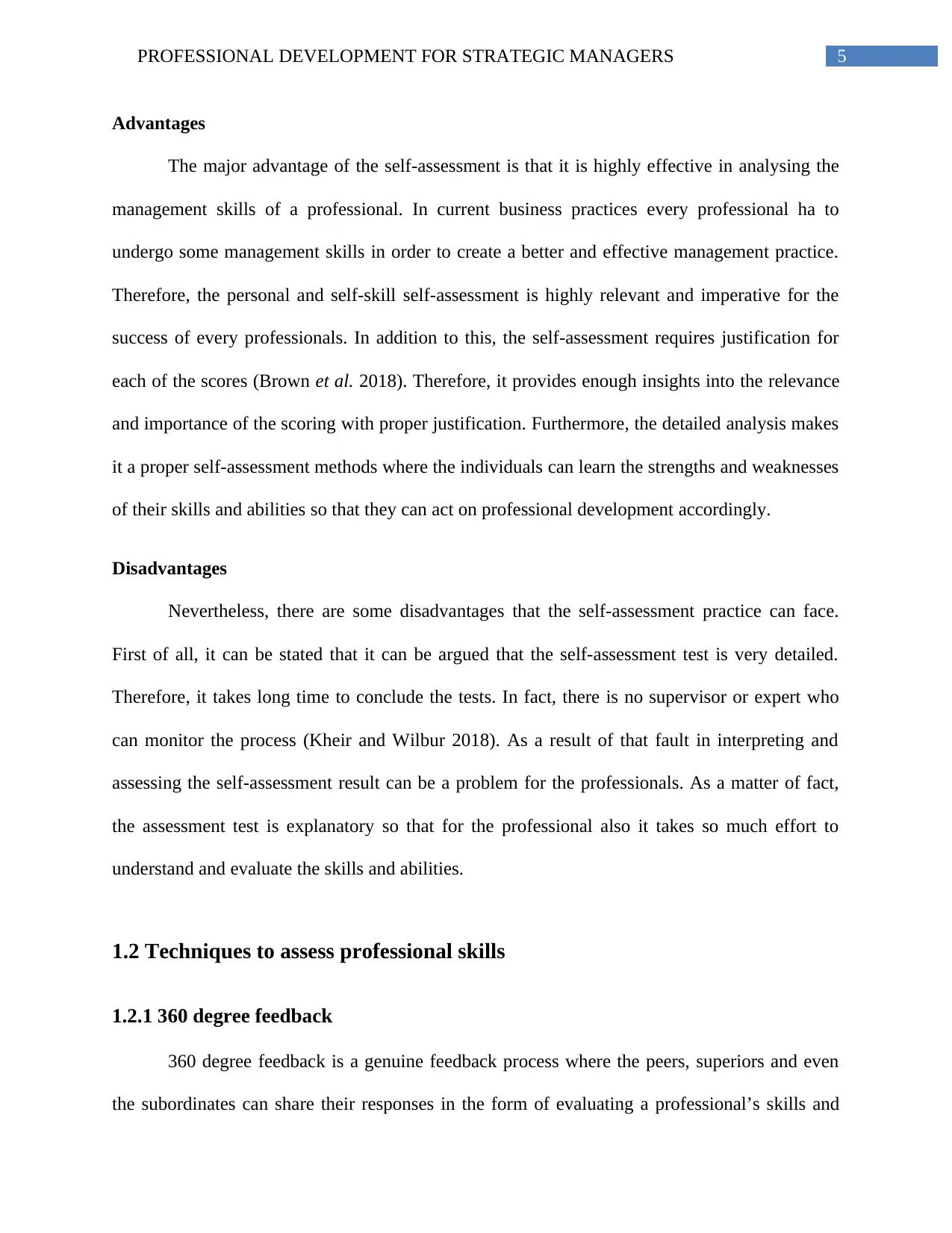
5PROFESSIONAL DEVELOPMENT FOR STRATEGIC MANAGERS
Advantages
The major advantage of the self-assessment is that it is highly effective in analysing the
management skills of a professional. In current business practices every professional ha to
undergo some management skills in order to create a better and effective management practice.
Therefore, the personal and self-skill self-assessment is highly relevant and imperative for the
success of every professionals. In addition to this, the self-assessment requires justification for
each of the scores (Brown et al. 2018). Therefore, it provides enough insights into the relevance
and importance of the scoring with proper justification. Furthermore, the detailed analysis makes
it a proper self-assessment methods where the individuals can learn the strengths and weaknesses
of their skills and abilities so that they can act on professional development accordingly.
Disadvantages
Nevertheless, there are some disadvantages that the self-assessment practice can face.
First of all, it can be stated that it can be argued that the self-assessment test is very detailed.
Therefore, it takes long time to conclude the tests. In fact, there is no supervisor or expert who
can monitor the process (Kheir and Wilbur 2018). As a result of that fault in interpreting and
assessing the self-assessment result can be a problem for the professionals. As a matter of fact,
the assessment test is explanatory so that for the professional also it takes so much effort to
understand and evaluate the skills and abilities.
1.2 Techniques to assess professional skills
1.2.1 360 degree feedback
360 degree feedback is a genuine feedback process where the peers, superiors and even
the subordinates can share their responses in the form of evaluating a professional’s skills and
Advantages
The major advantage of the self-assessment is that it is highly effective in analysing the
management skills of a professional. In current business practices every professional ha to
undergo some management skills in order to create a better and effective management practice.
Therefore, the personal and self-skill self-assessment is highly relevant and imperative for the
success of every professionals. In addition to this, the self-assessment requires justification for
each of the scores (Brown et al. 2018). Therefore, it provides enough insights into the relevance
and importance of the scoring with proper justification. Furthermore, the detailed analysis makes
it a proper self-assessment methods where the individuals can learn the strengths and weaknesses
of their skills and abilities so that they can act on professional development accordingly.
Disadvantages
Nevertheless, there are some disadvantages that the self-assessment practice can face.
First of all, it can be stated that it can be argued that the self-assessment test is very detailed.
Therefore, it takes long time to conclude the tests. In fact, there is no supervisor or expert who
can monitor the process (Kheir and Wilbur 2018). As a result of that fault in interpreting and
assessing the self-assessment result can be a problem for the professionals. As a matter of fact,
the assessment test is explanatory so that for the professional also it takes so much effort to
understand and evaluate the skills and abilities.
1.2 Techniques to assess professional skills
1.2.1 360 degree feedback
360 degree feedback is a genuine feedback process where the peers, superiors and even
the subordinates can share their responses in the form of evaluating a professional’s skills and
⊘ This is a preview!⊘
Do you want full access?
Subscribe today to unlock all pages.

Trusted by 1+ million students worldwide
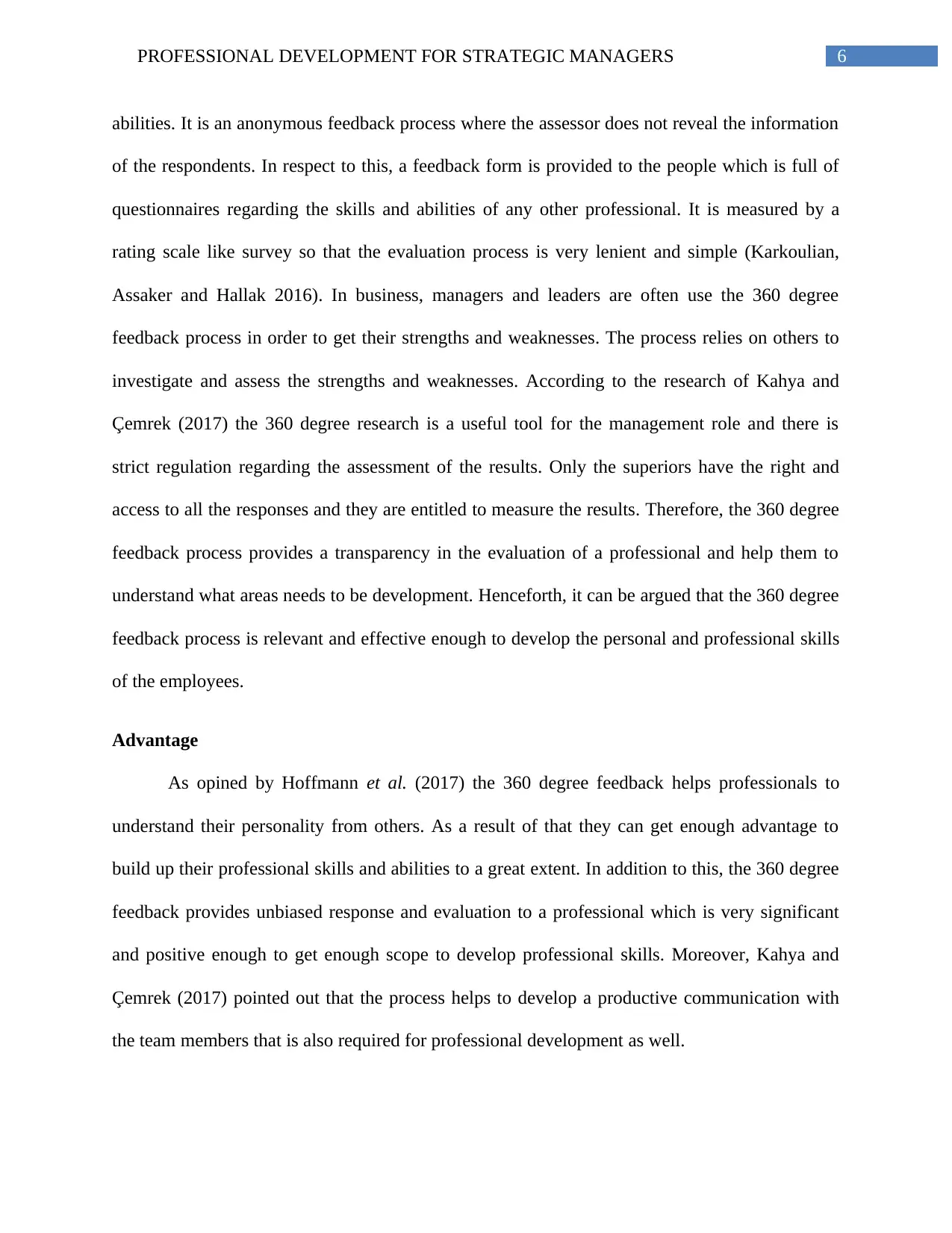
6PROFESSIONAL DEVELOPMENT FOR STRATEGIC MANAGERS
abilities. It is an anonymous feedback process where the assessor does not reveal the information
of the respondents. In respect to this, a feedback form is provided to the people which is full of
questionnaires regarding the skills and abilities of any other professional. It is measured by a
rating scale like survey so that the evaluation process is very lenient and simple (Karkoulian,
Assaker and Hallak 2016). In business, managers and leaders are often use the 360 degree
feedback process in order to get their strengths and weaknesses. The process relies on others to
investigate and assess the strengths and weaknesses. According to the research of Kahya and
Çemrek (2017) the 360 degree research is a useful tool for the management role and there is
strict regulation regarding the assessment of the results. Only the superiors have the right and
access to all the responses and they are entitled to measure the results. Therefore, the 360 degree
feedback process provides a transparency in the evaluation of a professional and help them to
understand what areas needs to be development. Henceforth, it can be argued that the 360 degree
feedback process is relevant and effective enough to develop the personal and professional skills
of the employees.
Advantage
As opined by Hoffmann et al. (2017) the 360 degree feedback helps professionals to
understand their personality from others. As a result of that they can get enough advantage to
build up their professional skills and abilities to a great extent. In addition to this, the 360 degree
feedback provides unbiased response and evaluation to a professional which is very significant
and positive enough to get enough scope to develop professional skills. Moreover, Kahya and
Çemrek (2017) pointed out that the process helps to develop a productive communication with
the team members that is also required for professional development as well.
abilities. It is an anonymous feedback process where the assessor does not reveal the information
of the respondents. In respect to this, a feedback form is provided to the people which is full of
questionnaires regarding the skills and abilities of any other professional. It is measured by a
rating scale like survey so that the evaluation process is very lenient and simple (Karkoulian,
Assaker and Hallak 2016). In business, managers and leaders are often use the 360 degree
feedback process in order to get their strengths and weaknesses. The process relies on others to
investigate and assess the strengths and weaknesses. According to the research of Kahya and
Çemrek (2017) the 360 degree research is a useful tool for the management role and there is
strict regulation regarding the assessment of the results. Only the superiors have the right and
access to all the responses and they are entitled to measure the results. Therefore, the 360 degree
feedback process provides a transparency in the evaluation of a professional and help them to
understand what areas needs to be development. Henceforth, it can be argued that the 360 degree
feedback process is relevant and effective enough to develop the personal and professional skills
of the employees.
Advantage
As opined by Hoffmann et al. (2017) the 360 degree feedback helps professionals to
understand their personality from others. As a result of that they can get enough advantage to
build up their professional skills and abilities to a great extent. In addition to this, the 360 degree
feedback provides unbiased response and evaluation to a professional which is very significant
and positive enough to get enough scope to develop professional skills. Moreover, Kahya and
Çemrek (2017) pointed out that the process helps to develop a productive communication with
the team members that is also required for professional development as well.
Paraphrase This Document
Need a fresh take? Get an instant paraphrase of this document with our AI Paraphraser
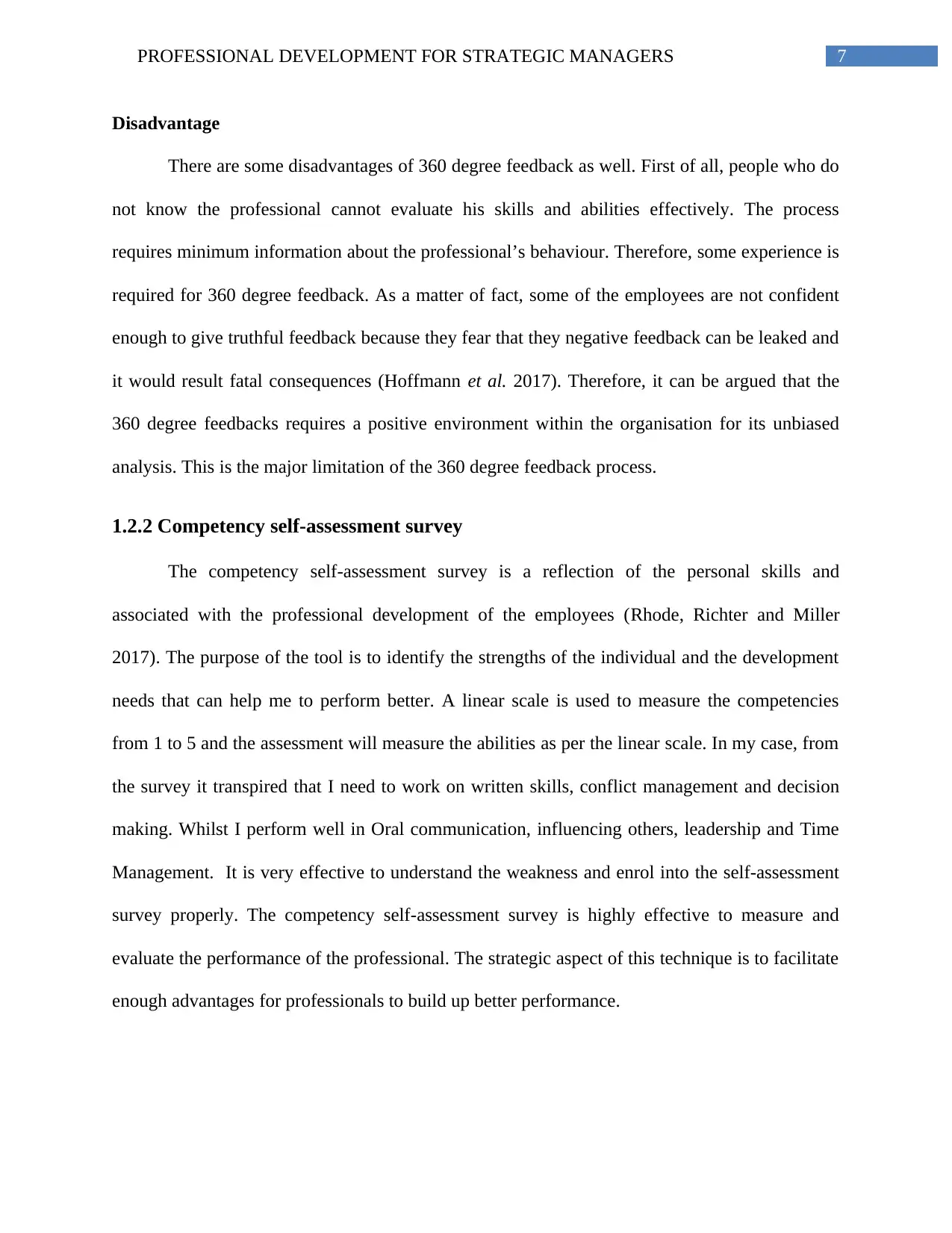
7PROFESSIONAL DEVELOPMENT FOR STRATEGIC MANAGERS
Disadvantage
There are some disadvantages of 360 degree feedback as well. First of all, people who do
not know the professional cannot evaluate his skills and abilities effectively. The process
requires minimum information about the professional’s behaviour. Therefore, some experience is
required for 360 degree feedback. As a matter of fact, some of the employees are not confident
enough to give truthful feedback because they fear that they negative feedback can be leaked and
it would result fatal consequences (Hoffmann et al. 2017). Therefore, it can be argued that the
360 degree feedbacks requires a positive environment within the organisation for its unbiased
analysis. This is the major limitation of the 360 degree feedback process.
1.2.2 Competency self-assessment survey
The competency self-assessment survey is a reflection of the personal skills and
associated with the professional development of the employees (Rhode, Richter and Miller
2017). The purpose of the tool is to identify the strengths of the individual and the development
needs that can help me to perform better. A linear scale is used to measure the competencies
from 1 to 5 and the assessment will measure the abilities as per the linear scale. In my case, from
the survey it transpired that I need to work on written skills, conflict management and decision
making. Whilst I perform well in Oral communication, influencing others, leadership and Time
Management. It is very effective to understand the weakness and enrol into the self-assessment
survey properly. The competency self-assessment survey is highly effective to measure and
evaluate the performance of the professional. The strategic aspect of this technique is to facilitate
enough advantages for professionals to build up better performance.
Disadvantage
There are some disadvantages of 360 degree feedback as well. First of all, people who do
not know the professional cannot evaluate his skills and abilities effectively. The process
requires minimum information about the professional’s behaviour. Therefore, some experience is
required for 360 degree feedback. As a matter of fact, some of the employees are not confident
enough to give truthful feedback because they fear that they negative feedback can be leaked and
it would result fatal consequences (Hoffmann et al. 2017). Therefore, it can be argued that the
360 degree feedbacks requires a positive environment within the organisation for its unbiased
analysis. This is the major limitation of the 360 degree feedback process.
1.2.2 Competency self-assessment survey
The competency self-assessment survey is a reflection of the personal skills and
associated with the professional development of the employees (Rhode, Richter and Miller
2017). The purpose of the tool is to identify the strengths of the individual and the development
needs that can help me to perform better. A linear scale is used to measure the competencies
from 1 to 5 and the assessment will measure the abilities as per the linear scale. In my case, from
the survey it transpired that I need to work on written skills, conflict management and decision
making. Whilst I perform well in Oral communication, influencing others, leadership and Time
Management. It is very effective to understand the weakness and enrol into the self-assessment
survey properly. The competency self-assessment survey is highly effective to measure and
evaluate the performance of the professional. The strategic aspect of this technique is to facilitate
enough advantages for professionals to build up better performance.
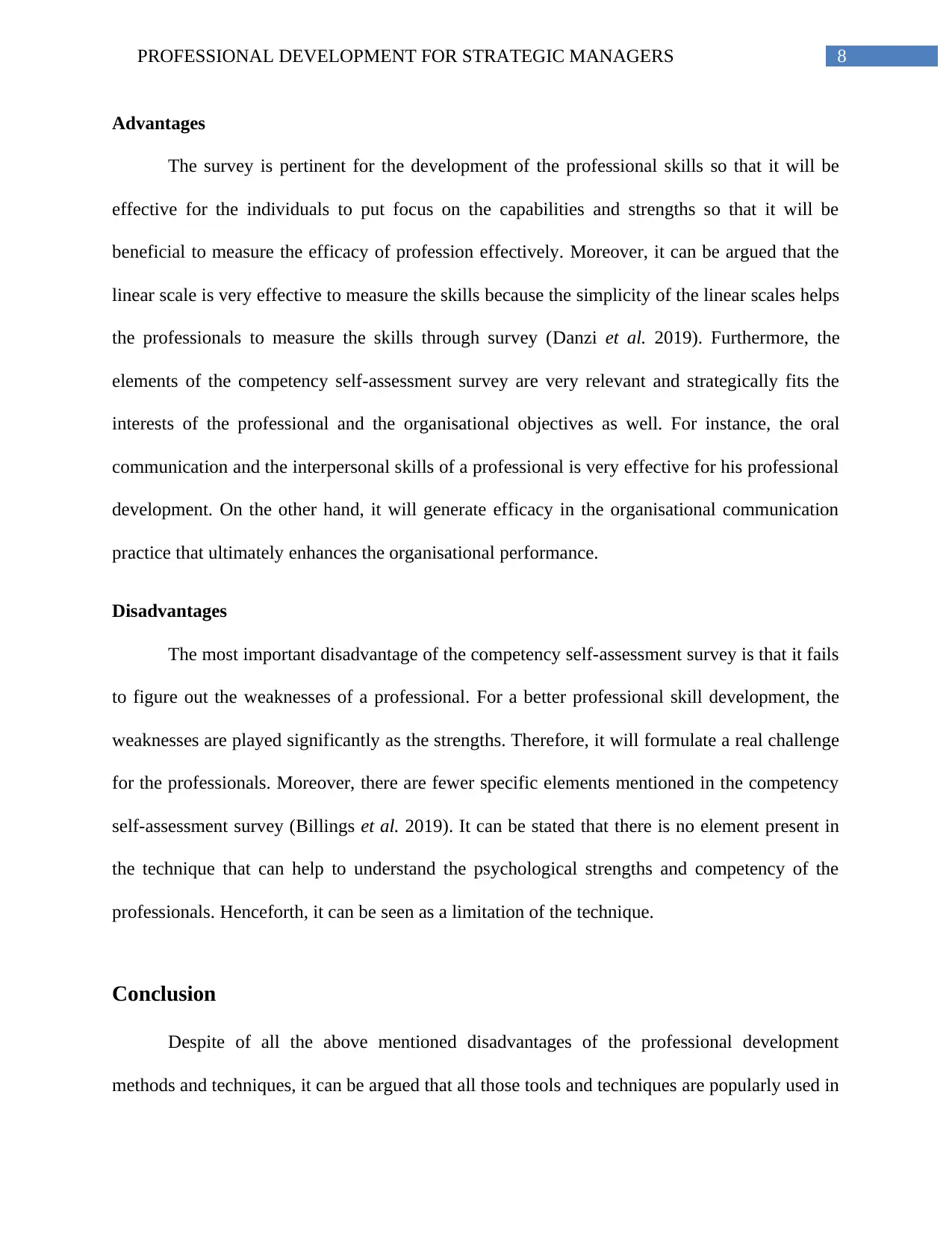
8PROFESSIONAL DEVELOPMENT FOR STRATEGIC MANAGERS
Advantages
The survey is pertinent for the development of the professional skills so that it will be
effective for the individuals to put focus on the capabilities and strengths so that it will be
beneficial to measure the efficacy of profession effectively. Moreover, it can be argued that the
linear scale is very effective to measure the skills because the simplicity of the linear scales helps
the professionals to measure the skills through survey (Danzi et al. 2019). Furthermore, the
elements of the competency self-assessment survey are very relevant and strategically fits the
interests of the professional and the organisational objectives as well. For instance, the oral
communication and the interpersonal skills of a professional is very effective for his professional
development. On the other hand, it will generate efficacy in the organisational communication
practice that ultimately enhances the organisational performance.
Disadvantages
The most important disadvantage of the competency self-assessment survey is that it fails
to figure out the weaknesses of a professional. For a better professional skill development, the
weaknesses are played significantly as the strengths. Therefore, it will formulate a real challenge
for the professionals. Moreover, there are fewer specific elements mentioned in the competency
self-assessment survey (Billings et al. 2019). It can be stated that there is no element present in
the technique that can help to understand the psychological strengths and competency of the
professionals. Henceforth, it can be seen as a limitation of the technique.
Conclusion
Despite of all the above mentioned disadvantages of the professional development
methods and techniques, it can be argued that all those tools and techniques are popularly used in
Advantages
The survey is pertinent for the development of the professional skills so that it will be
effective for the individuals to put focus on the capabilities and strengths so that it will be
beneficial to measure the efficacy of profession effectively. Moreover, it can be argued that the
linear scale is very effective to measure the skills because the simplicity of the linear scales helps
the professionals to measure the skills through survey (Danzi et al. 2019). Furthermore, the
elements of the competency self-assessment survey are very relevant and strategically fits the
interests of the professional and the organisational objectives as well. For instance, the oral
communication and the interpersonal skills of a professional is very effective for his professional
development. On the other hand, it will generate efficacy in the organisational communication
practice that ultimately enhances the organisational performance.
Disadvantages
The most important disadvantage of the competency self-assessment survey is that it fails
to figure out the weaknesses of a professional. For a better professional skill development, the
weaknesses are played significantly as the strengths. Therefore, it will formulate a real challenge
for the professionals. Moreover, there are fewer specific elements mentioned in the competency
self-assessment survey (Billings et al. 2019). It can be stated that there is no element present in
the technique that can help to understand the psychological strengths and competency of the
professionals. Henceforth, it can be seen as a limitation of the technique.
Conclusion
Despite of all the above mentioned disadvantages of the professional development
methods and techniques, it can be argued that all those tools and techniques are popularly used in
⊘ This is a preview!⊘
Do you want full access?
Subscribe today to unlock all pages.

Trusted by 1+ million students worldwide
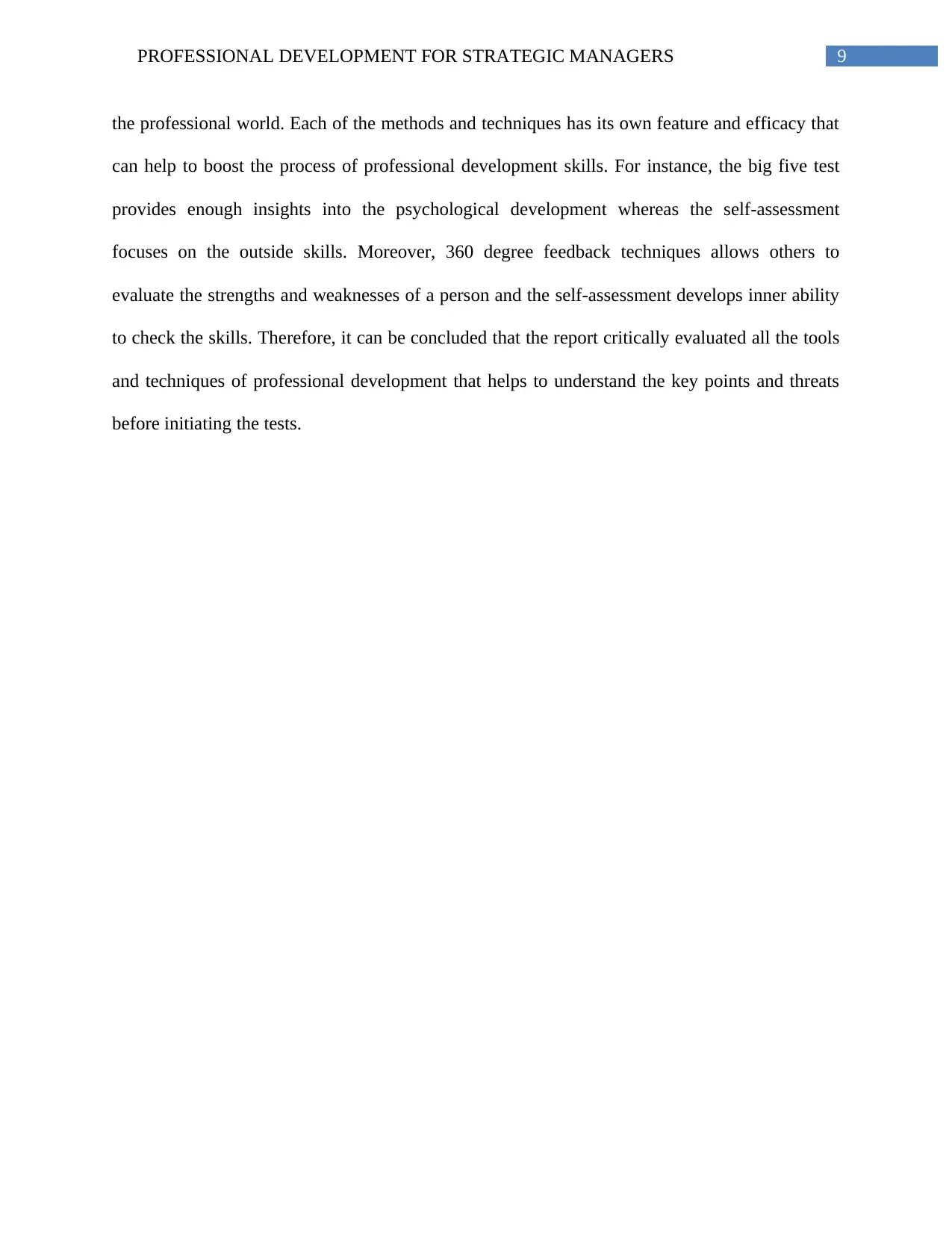
9PROFESSIONAL DEVELOPMENT FOR STRATEGIC MANAGERS
the professional world. Each of the methods and techniques has its own feature and efficacy that
can help to boost the process of professional development skills. For instance, the big five test
provides enough insights into the psychological development whereas the self-assessment
focuses on the outside skills. Moreover, 360 degree feedback techniques allows others to
evaluate the strengths and weaknesses of a person and the self-assessment develops inner ability
to check the skills. Therefore, it can be concluded that the report critically evaluated all the tools
and techniques of professional development that helps to understand the key points and threats
before initiating the tests.
the professional world. Each of the methods and techniques has its own feature and efficacy that
can help to boost the process of professional development skills. For instance, the big five test
provides enough insights into the psychological development whereas the self-assessment
focuses on the outside skills. Moreover, 360 degree feedback techniques allows others to
evaluate the strengths and weaknesses of a person and the self-assessment develops inner ability
to check the skills. Therefore, it can be concluded that the report critically evaluated all the tools
and techniques of professional development that helps to understand the key points and threats
before initiating the tests.
Paraphrase This Document
Need a fresh take? Get an instant paraphrase of this document with our AI Paraphraser
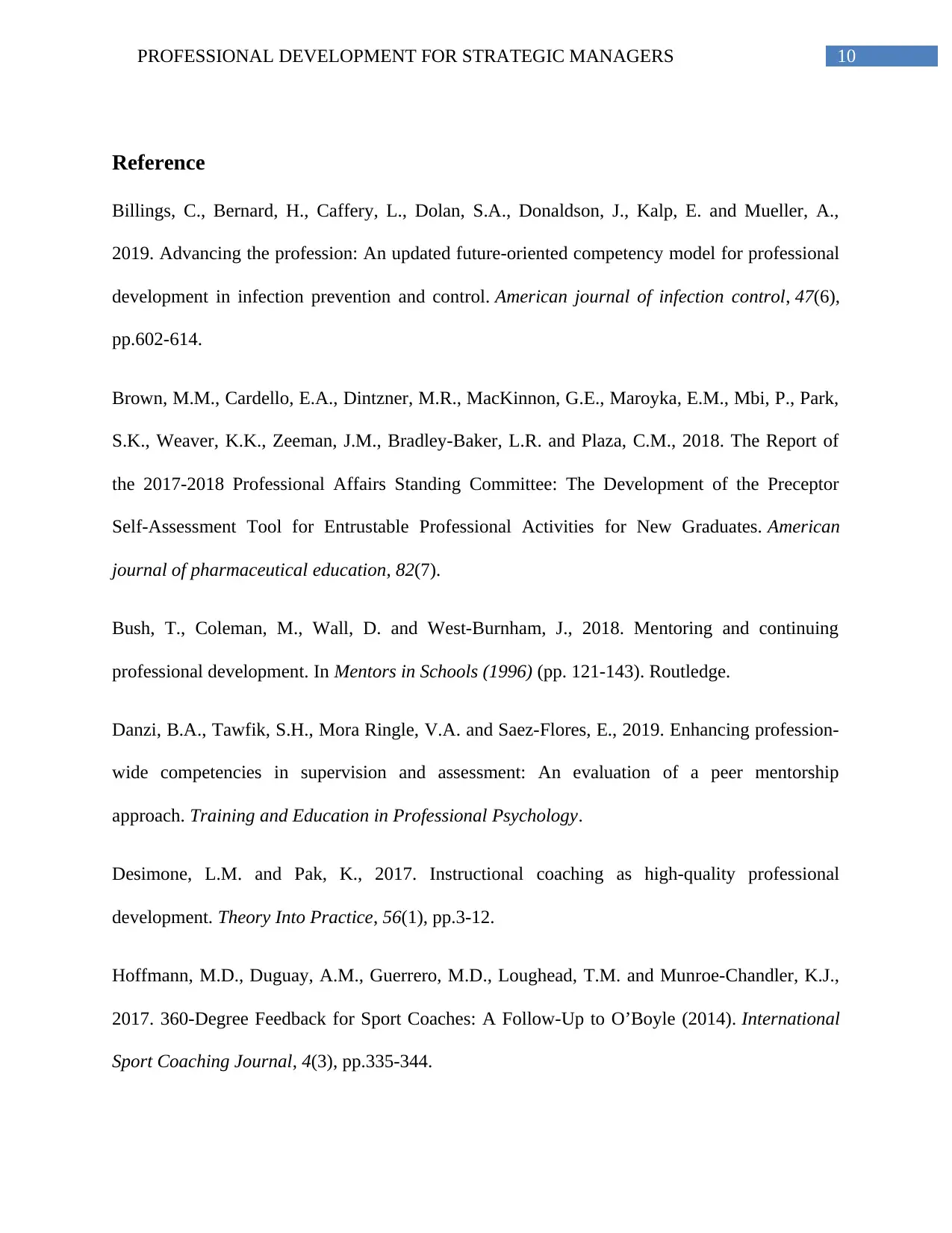
10PROFESSIONAL DEVELOPMENT FOR STRATEGIC MANAGERS
Reference
Billings, C., Bernard, H., Caffery, L., Dolan, S.A., Donaldson, J., Kalp, E. and Mueller, A.,
2019. Advancing the profession: An updated future-oriented competency model for professional
development in infection prevention and control. American journal of infection control, 47(6),
pp.602-614.
Brown, M.M., Cardello, E.A., Dintzner, M.R., MacKinnon, G.E., Maroyka, E.M., Mbi, P., Park,
S.K., Weaver, K.K., Zeeman, J.M., Bradley-Baker, L.R. and Plaza, C.M., 2018. The Report of
the 2017-2018 Professional Affairs Standing Committee: The Development of the Preceptor
Self-Assessment Tool for Entrustable Professional Activities for New Graduates. American
journal of pharmaceutical education, 82(7).
Bush, T., Coleman, M., Wall, D. and West-Burnham, J., 2018. Mentoring and continuing
professional development. In Mentors in Schools (1996) (pp. 121-143). Routledge.
Danzi, B.A., Tawfik, S.H., Mora Ringle, V.A. and Saez-Flores, E., 2019. Enhancing profession-
wide competencies in supervision and assessment: An evaluation of a peer mentorship
approach. Training and Education in Professional Psychology.
Desimone, L.M. and Pak, K., 2017. Instructional coaching as high-quality professional
development. Theory Into Practice, 56(1), pp.3-12.
Hoffmann, M.D., Duguay, A.M., Guerrero, M.D., Loughead, T.M. and Munroe-Chandler, K.J.,
2017. 360-Degree Feedback for Sport Coaches: A Follow-Up to O’Boyle (2014). International
Sport Coaching Journal, 4(3), pp.335-344.
Reference
Billings, C., Bernard, H., Caffery, L., Dolan, S.A., Donaldson, J., Kalp, E. and Mueller, A.,
2019. Advancing the profession: An updated future-oriented competency model for professional
development in infection prevention and control. American journal of infection control, 47(6),
pp.602-614.
Brown, M.M., Cardello, E.A., Dintzner, M.R., MacKinnon, G.E., Maroyka, E.M., Mbi, P., Park,
S.K., Weaver, K.K., Zeeman, J.M., Bradley-Baker, L.R. and Plaza, C.M., 2018. The Report of
the 2017-2018 Professional Affairs Standing Committee: The Development of the Preceptor
Self-Assessment Tool for Entrustable Professional Activities for New Graduates. American
journal of pharmaceutical education, 82(7).
Bush, T., Coleman, M., Wall, D. and West-Burnham, J., 2018. Mentoring and continuing
professional development. In Mentors in Schools (1996) (pp. 121-143). Routledge.
Danzi, B.A., Tawfik, S.H., Mora Ringle, V.A. and Saez-Flores, E., 2019. Enhancing profession-
wide competencies in supervision and assessment: An evaluation of a peer mentorship
approach. Training and Education in Professional Psychology.
Desimone, L.M. and Pak, K., 2017. Instructional coaching as high-quality professional
development. Theory Into Practice, 56(1), pp.3-12.
Hoffmann, M.D., Duguay, A.M., Guerrero, M.D., Loughead, T.M. and Munroe-Chandler, K.J.,
2017. 360-Degree Feedback for Sport Coaches: A Follow-Up to O’Boyle (2014). International
Sport Coaching Journal, 4(3), pp.335-344.
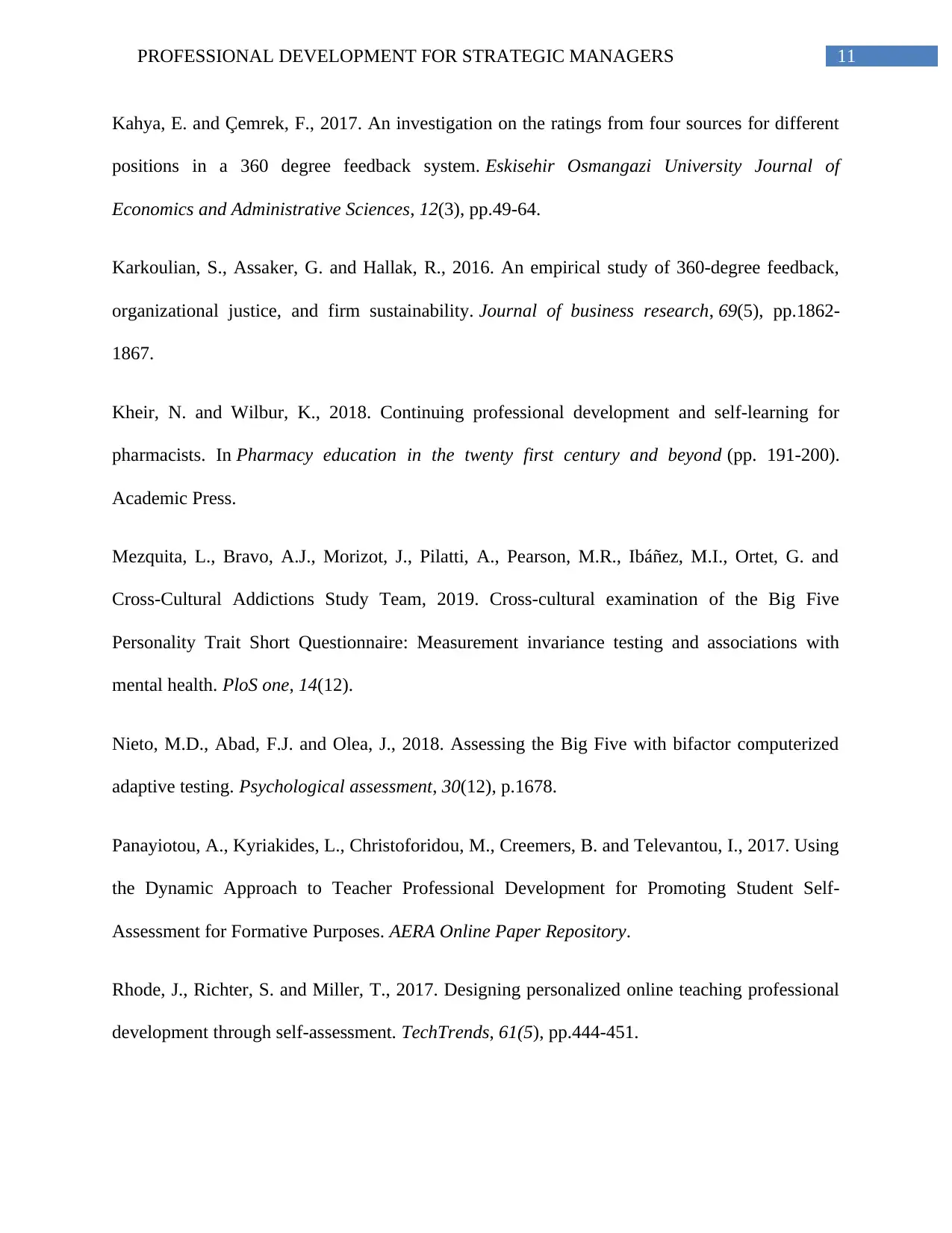
11PROFESSIONAL DEVELOPMENT FOR STRATEGIC MANAGERS
Kahya, E. and Çemrek, F., 2017. An investigation on the ratings from four sources for different
positions in a 360 degree feedback system. Eskisehir Osmangazi University Journal of
Economics and Administrative Sciences, 12(3), pp.49-64.
Karkoulian, S., Assaker, G. and Hallak, R., 2016. An empirical study of 360-degree feedback,
organizational justice, and firm sustainability. Journal of business research, 69(5), pp.1862-
1867.
Kheir, N. and Wilbur, K., 2018. Continuing professional development and self-learning for
pharmacists. In Pharmacy education in the twenty first century and beyond (pp. 191-200).
Academic Press.
Mezquita, L., Bravo, A.J., Morizot, J., Pilatti, A., Pearson, M.R., Ibáñez, M.I., Ortet, G. and
Cross-Cultural Addictions Study Team, 2019. Cross-cultural examination of the Big Five
Personality Trait Short Questionnaire: Measurement invariance testing and associations with
mental health. PloS one, 14(12).
Nieto, M.D., Abad, F.J. and Olea, J., 2018. Assessing the Big Five with bifactor computerized
adaptive testing. Psychological assessment, 30(12), p.1678.
Panayiotou, A., Kyriakides, L., Christoforidou, M., Creemers, B. and Televantou, I., 2017. Using
the Dynamic Approach to Teacher Professional Development for Promoting Student Self-
Assessment for Formative Purposes. AERA Online Paper Repository.
Rhode, J., Richter, S. and Miller, T., 2017. Designing personalized online teaching professional
development through self-assessment. TechTrends, 61(5), pp.444-451.
Kahya, E. and Çemrek, F., 2017. An investigation on the ratings from four sources for different
positions in a 360 degree feedback system. Eskisehir Osmangazi University Journal of
Economics and Administrative Sciences, 12(3), pp.49-64.
Karkoulian, S., Assaker, G. and Hallak, R., 2016. An empirical study of 360-degree feedback,
organizational justice, and firm sustainability. Journal of business research, 69(5), pp.1862-
1867.
Kheir, N. and Wilbur, K., 2018. Continuing professional development and self-learning for
pharmacists. In Pharmacy education in the twenty first century and beyond (pp. 191-200).
Academic Press.
Mezquita, L., Bravo, A.J., Morizot, J., Pilatti, A., Pearson, M.R., Ibáñez, M.I., Ortet, G. and
Cross-Cultural Addictions Study Team, 2019. Cross-cultural examination of the Big Five
Personality Trait Short Questionnaire: Measurement invariance testing and associations with
mental health. PloS one, 14(12).
Nieto, M.D., Abad, F.J. and Olea, J., 2018. Assessing the Big Five with bifactor computerized
adaptive testing. Psychological assessment, 30(12), p.1678.
Panayiotou, A., Kyriakides, L., Christoforidou, M., Creemers, B. and Televantou, I., 2017. Using
the Dynamic Approach to Teacher Professional Development for Promoting Student Self-
Assessment for Formative Purposes. AERA Online Paper Repository.
Rhode, J., Richter, S. and Miller, T., 2017. Designing personalized online teaching professional
development through self-assessment. TechTrends, 61(5), pp.444-451.
⊘ This is a preview!⊘
Do you want full access?
Subscribe today to unlock all pages.

Trusted by 1+ million students worldwide
1 out of 13
Related Documents
Your All-in-One AI-Powered Toolkit for Academic Success.
+13062052269
info@desklib.com
Available 24*7 on WhatsApp / Email
![[object Object]](/_next/static/media/star-bottom.7253800d.svg)
Unlock your academic potential
Copyright © 2020–2025 A2Z Services. All Rights Reserved. Developed and managed by ZUCOL.





